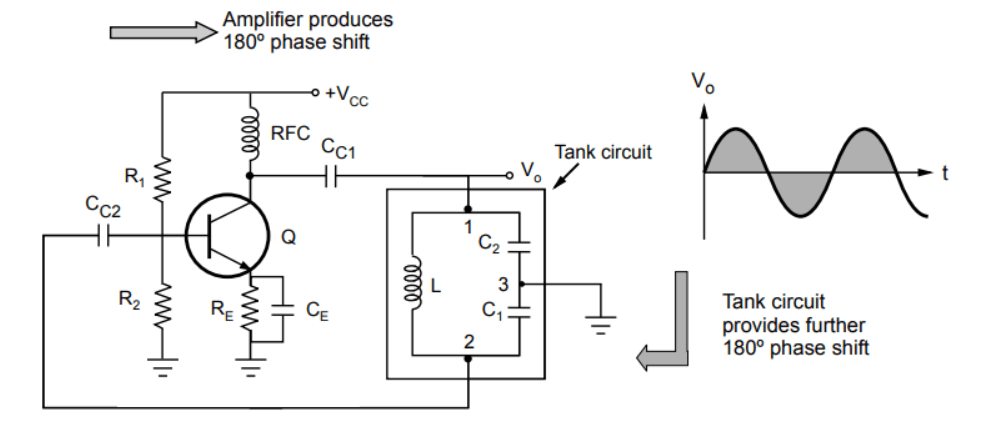Colpitts Oscillator
The Colpitts oscillator is similar to the Hartley oscillator, but it uses a different arrangement for the tank circuit components. Instead of using inductors and capacitors in the same configuration as the Hartley oscillator, the Colpitts oscillator swaps their roles.
Working of the Colpitts Oscillator
The figure below shows a Colpitts oscillator using a BJT amplifier stage.

In this circuit, the amplifier stage uses a BJT in a common emitter configuration to provide a phase shift. The resistors , , and are biasing resistors.
-
The RFC (radio frequency choke) provides isolation between AC and DC operations. The capacitors and are coupling capacitors. In the feedback circuit, the center tap of and is grounded, providing an additional phase shift, which satisfies the Barkhausen criterion.
-
In this oscillator:
-
For the LC oscillator, the condition is:
To satisfy the magnitude condition of the Barkhausen criterion, the of the BJT used is:
Derivation of Frequency of Oscillations
The equivalent circuit and simplified equivalent circuit are shown below.

In the simplified equivalent circuit:
-
-
The total current is:
Using the current division rule for parallel elements:
To have the imaginary part of the above equation equal to zero:
Substituting this result for into equation (i) for and equating magnitudes of both sides:
Advantages
- The Colpitts oscillator can generate sinusoidal signals of very high frequencies.
- It has good temperature stability.
- Frequency stability is high.
- The frequency can be varied using both variable capacitors.
- Fewer components are required.
- The amplitude of the output remains constant over a fixed frequency range.
Disadvantages
- Adjusting the feedback can be challenging.
- It has relatively poor isolation.
Applications
- The Colpitts oscillator is used as a high-frequency sine wave generator.
- It can be used as a temperature sensor with additional circuitry.
- Commonly used as a local oscillator in radio receivers.
- Used as an RF oscillator.
- Applied in mobile communications and other commercial applications.